Cocoa butter is a versatile ingredient with a wide range of uses and benefits. It is a type of fat derived from cocoa beans and has been used for centuries in various culinary and personal care products. Cocoa butter is rich in fatty acids, which make it an excellent moisturizer for the skin and can improve its elasticity. It is also high in natural plant compounds called phytochemicals, which may protect the skin from sun damage and slow down skin aging. Some common uses of cocoa butter include reducing scars, preventing and minimizing stretch marks, and treating skin conditions like eczema and dermatitis. While there is limited scientific evidence supporting these claims, many people use cocoa butter for its pleasant texture and potential skincare benefits.
Key Takeaways:
- Cocoa butter is derived from cocoa beans and has moisturizing properties for the skin and hair.
- It contains phytochemicals that may protect the skin from sun damage and slow down skin aging.
- Cocoa butter is commonly used to reduce scars, prevent stretch marks, and treat skin conditions like eczema.
- Scientific evidence for cocoa butter’s specific benefits is limited, but many people find it beneficial for their skincare routine.
- Consult with a dermatologist for personalized skincare advice.
The History and Origin of Cocoa Butter
Cocoa butter has a fascinating history that stretches back thousands of years. It was highly valued by ancient civilizations such as the Aztecs and Mayans, who recognized its many uses and even used cocoa beans as a form of currency. The process of creating cocoa butter involves extracting the fat from cocoa beans, which is then further refined and processed into cocoa powder.
Over the centuries, cocoa butter has been widely used for its potential health benefits and moisturizing properties in both medicine and skincare. It is primarily derived from cocoa beans, which are grown in tropical regions around the world. Today, the majority of cocoa beans come from West African countries like Ghana, Nigeria, Cameroon, and Ivory Coast.
Key Points:
- Cocoa butter has a long history and was valued by ancient civilizations.
- It is extracted from cocoa beans and further processed into cocoa powder.
- Cocoa butter has been used in medicine and skincare for its potential health benefits.
- The majority of cocoa beans used to produce cocoa butter come from West African countries.
| Key Facts about Cocoa Butter | |
|---|---|
| Uses in Ancient Civilizations | Valued by the Aztecs and Mayans who even used cocoa beans as currency. |
| Extraction Process | Cocoa beans are processed to extract the fat, which is then further refined into cocoa powder. |
| Medicinal and Skincare Uses | Cocoa butter has been used for its potential health benefits and moisturizing properties. |
| Origin of Cocoa Beans | The majority of cocoa beans come from West African countries like Ghana, Nigeria, Cameroon, and Ivory Coast. |
Properties and Key Components of Cocoa Butter
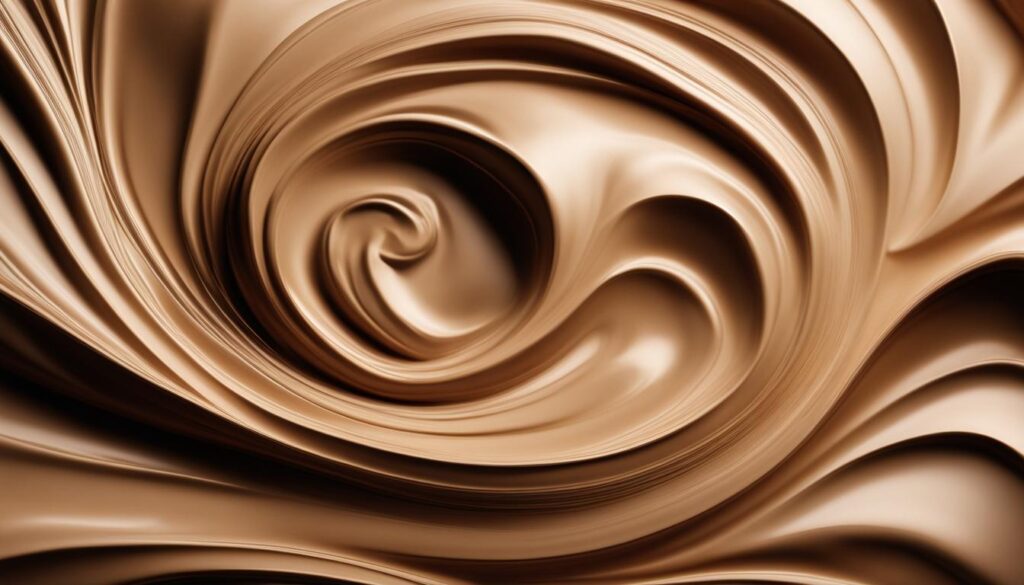
Cocoa butter, derived from cocoa beans, possesses unique properties owing to its composition of various fatty acids. The key components of cocoa butter include stearic acid, oleic acid, and palmitic acid. These fatty acids contribute to its high fat content and moisturizing abilities, allowing it to form a protective barrier on the skin and prevent moisture loss.
In addition to its fatty acid composition, cocoa butter contains natural plant compounds called phytochemicals. These phytochemicals possess antioxidant and anti-inflammatory properties that can benefit the skin. They may improve blood flow to the skin and provide protection against damage caused by harmful UV rays.
Cocoa butter also contains trace amounts of essential vitamins, including vitamin E and vitamin K, which offer additional benefits for the skin. Vitamin E is known for its antioxidant properties and can help protect the skin from free radicals, while vitamin K may assist in soothing and reducing the appearance of scars and stretch marks.
Key Components of Cocoa Butter
| Component | Properties |
|---|---|
| Stearic Acid | Contributes to the firmness and stability of cocoa butter |
| Oleic Acid | Moisturizes and softens the skin |
| Palmitic Acid | Forms a protective barrier on the skin, preventing moisture loss |
| Phytochemicals | Provide antioxidant and anti-inflammatory properties |
| Vitamin E | Offers antioxidant protection |
| Vitamin K | May help reduce the appearance of scars and stretch marks |
Overall, the properties and key components of cocoa butter contribute to its effectiveness as a moisturizer and potential benefits for the skin.
Culinary Uses of Cocoa Butter
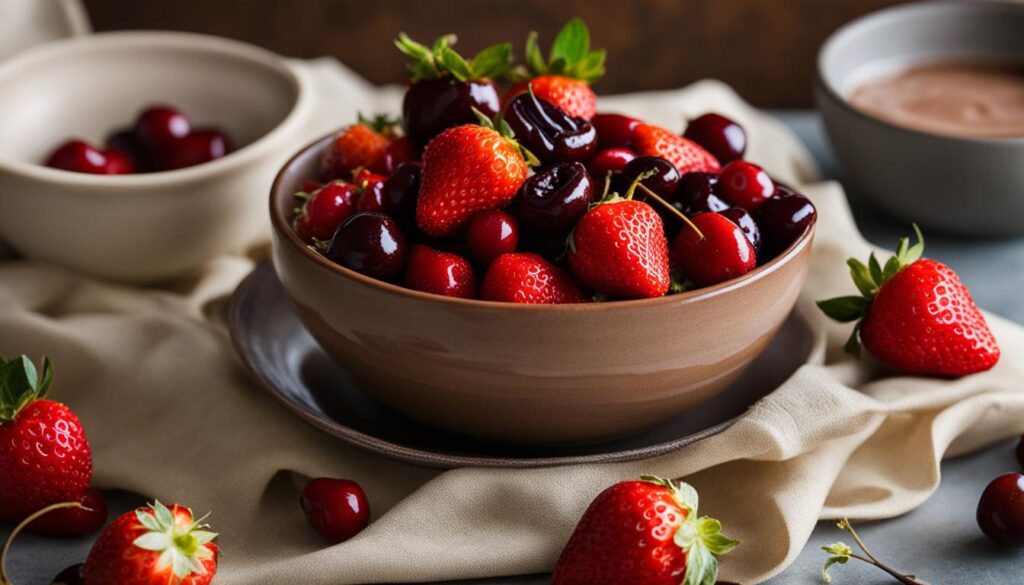
Cocoa butter is a versatile ingredient that has gained popularity in the culinary world. It is widely used in the production of chocolate, where it contributes to the smooth texture and rich flavor that we all love. But its uses go beyond just chocolate making.
When it comes to desserts, cocoa butter can be a game-changer. It can be incorporated into various recipes, such as chocolate chip cookies, brownies, and vegan desserts, adding a delectable touch of chocolatey flavor. Its high smoke point makes it suitable for high-temperature cooking, making it a versatile substitute for other oils in recipes.
Some culinary enthusiasts even use cocoa butter as a foundation for creating their own homemade chocolate. This process can be complex but allows for endless possibilities in terms of flavors and creative combinations.
Here is a mouthwatering example recipe that showcases the culinary uses of cocoa butter:
Decadent Cocoa Butter Truffles
- Ingredients:
- – 1 cup cocoa butter
- – 1/2 cup cocoa powder
- – 1/2 cup powdered sugar
- – 1 teaspoon vanilla extract
- – Optional: crushed nuts, shredded coconut, or cocoa powder for coating
- Instructions:
- 1. Melt the cocoa butter in a double boiler or microwave, ensuring it doesn’t overheat.
- 2. In a separate bowl, whisk together the cocoa powder and powdered sugar.
- 3. Pour the melted cocoa butter into the dry mixture and stir until smooth.
- 4. Add the vanilla extract and mix well.
- 5. Allow the mixture to cool slightly, then refrigerate it for about an hour or until it becomes firm enough to handle.
- 6. Shape the cocoa butter mixture into small truffle-sized balls.
- 7. Roll the truffles in crushed nuts, shredded coconut, or cocoa powder for an extra touch of flavor and texture.
- 8. Refrigerate the truffles for another 30 minutes to set.
- 9. Serve and enjoy these velvety, homemade cocoa butter truffles.
The culinary uses of cocoa butter are not limited to desserts. Its versatility extends to savory dishes as well. For example, you can use cocoa butter in sauces, rubs, or marinades to add a unique and rich flavor profile to your meat or poultry dishes. The possibilities are endless, limited only by your imagination and taste preferences.
Whether you’re a professional chef or an enthusiastic home cook, experimenting with cocoa butter in your recipes can elevate the flavors and create unforgettable culinary experiences.
Explore the culinary world of cocoa butter and unleash your creativity in the kitchen!
Personal Care and Household Uses of Cocoa Butter
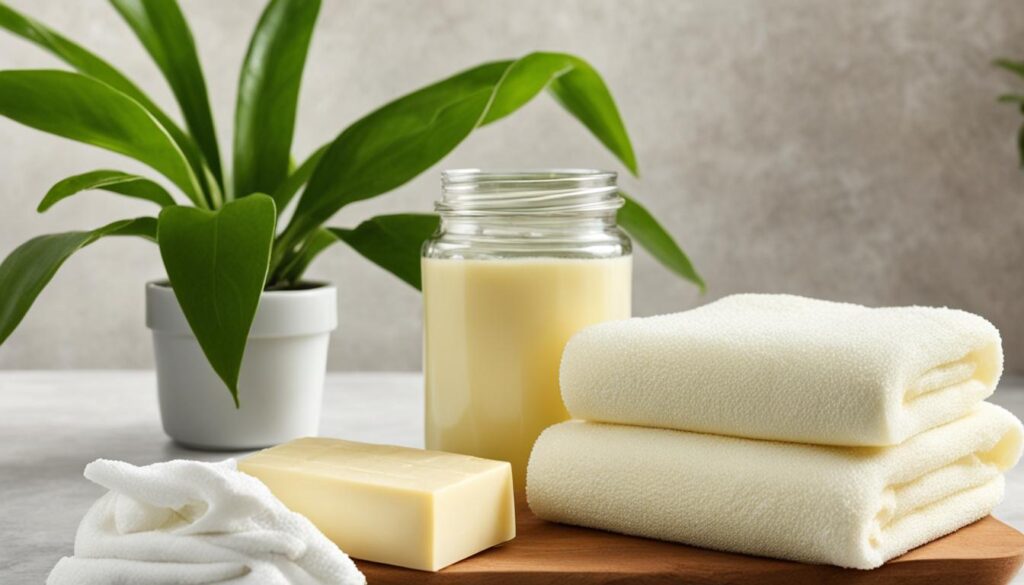
In addition to its culinary uses, cocoa butter is a versatile ingredient with a wide range of applications in personal care and household products. Known for its moisturizing properties, cocoa butter is a common ingredient found in moisturizers, lotions, and lip balms, providing hydration and potentially benefiting the skin.
Many people turn to cocoa butter to address various skin concerns, including the improvement of scars, wrinkles, and stretch marks. While scientific evidence supporting these claims may be limited, cocoa butter’s potential benefits have made it a popular choice for individuals seeking natural skincare solutions.
Cocoa butter is also used in hair care products, as it is believed to nourish and moisturize the hair. Its hydrating properties may contribute to healthier-looking hair and scalp.
Moreover, cocoa butter can be utilized in do-it-yourself (DIY) personal care creations. By substituting other oils with cocoa butter, individuals can customize their own natural personal care products, such as homemade shampoos and shaving lotions, allowing for a more personalized approach to personal care routines.
Additionally, cocoa butter is not limited to personal care uses alone and can be found in various household products. Its pleasant scent and texture make it a popular choice for candles and soaps, providing a touch of natural indulgence and enhancing the overall sensory experience.
Benefits and Applications of Cocoa Butter
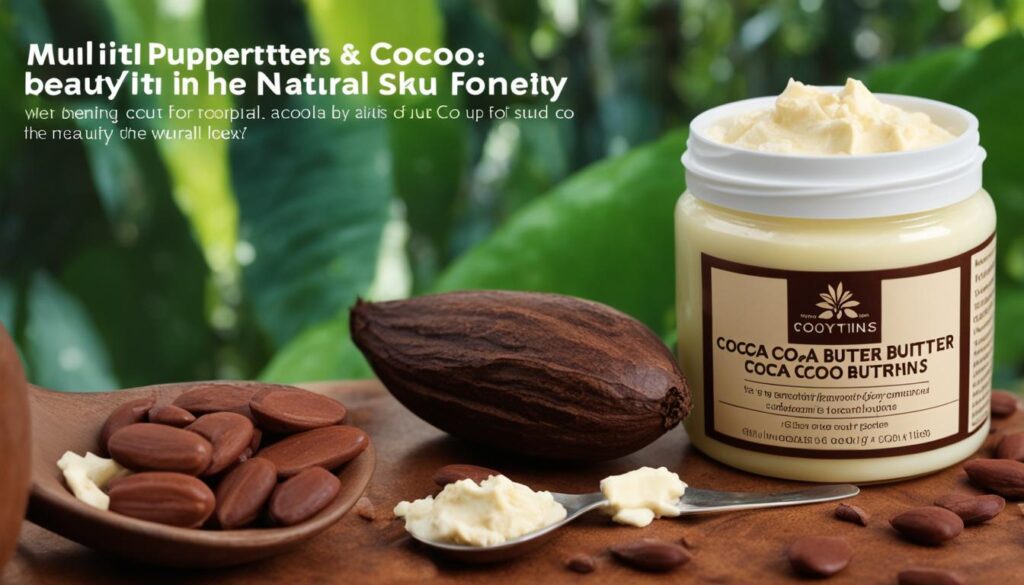
Cocoa butter offers numerous benefits for skincare, making it a popular choice in various beauty products. Its moisturizing properties help to hydrate and improve the elasticity of the skin, making it a valuable ingredient in anti-aging creams and lotions. In addition, cocoa butter contains phytochemicals that may protect the skin from sun damage and reduce inflammation.
While scientific research on the specific benefits of cocoa butter is limited, many individuals have found it beneficial for soothing dry and irritated skin, as well as reducing the appearance of scars and stretch marks. It’s also believed to promote overall skin health.
Although individual results may vary, incorporating cocoa butter into your skincare routine may provide moisturization and potential healing properties for various skin concerns.
To fully understand the potential benefits and determine the best approach for your skincare needs, it’s always advisable to consult with a dermatologist or skincare professional.
| Benefits of Cocoa Butter | Applications of Cocoa Butter |
|---|---|
|
|
Quote:
“Incorporating cocoa butter into your skincare routine can add moisture and potential healing properties to your daily regimen.” – sda23, Skincare Expert
While cocoa butter is not a cure-all, it is a valuable addition to skincare products and routines. Its potential benefits and applications make it a versatile ingredient, catering to a wide range of skincare needs.
Usage Tips and Cautions
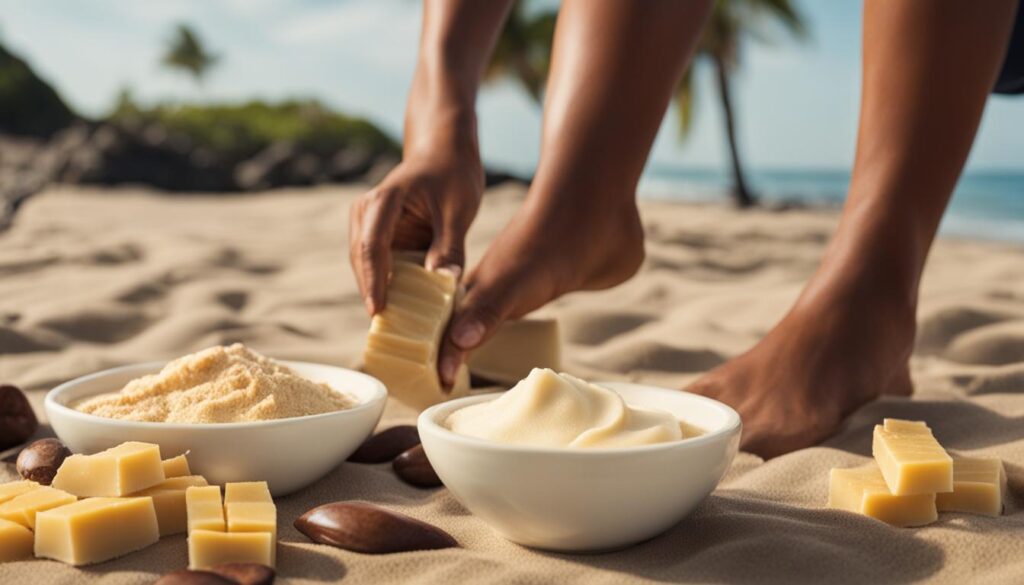
When it comes to using cocoa butter, there are a few important tips and cautions to keep in mind to ensure the best results:
- Choose high-quality cocoa butter: Opt for pure and unrefined cocoa butter without any additives or artificial ingredients. This ensures that you are getting the most out of the product’s benefits.
- Perform a patch test: Before applying cocoa butter to a larger area of your skin, especially if you have sensitive skin or known allergies, it’s recommended to conduct a patch test. Apply a small amount of cocoa butter to a small section of your skin and wait for any adverse reactions before proceeding.
- Be aware of potential skin reactions: While cocoa butter is generally safe for topical use, some individuals may experience skin irritation or allergic reactions. If you notice any adverse effects such as redness, itching, or swelling, discontinue use immediately and consult a dermatologist.
- Store cocoa butter properly: To prevent melting or rancidity, store your cocoa butter in a cool, dry place. Exposure to heat or direct sunlight can compromise its quality and effectiveness.
Caution:
Individuals with a history of allergies or sensitive skin should exercise caution when using cocoa butter. It’s always best to consult with a healthcare professional or dermatologist if you have any concerns or questions regarding the use of cocoa butter.
By following these tips and being aware of potential cautions, you can make the most of your cocoa butter experience and enjoy its benefits safely.
Selecting the Best Quality Cocoa Butter

When it comes to selecting cocoa butter, it’s important to choose the best quality product to ensure maximum benefits. Here are some tips to help you make the right choice.
Pure and Unrefined
Look for cocoa butter that is pure and unrefined. This means it hasn’t undergone any chemical processing or had any additives added to it. Pure cocoa butter retains its natural properties and is more likely to provide the desired effects.
Avoid Additives and Artificial Ingredients
Steer clear of cocoa butter products that contain additives, fillers, or artificial ingredients. These additional substances can dilute the effectiveness of cocoa butter and may even cause adverse reactions.
Choose Reputable Brands
Opt for cocoa butter from reputable brands or sources that prioritize sustainability and fair trade practices. By doing so, you support ethical and responsible practices in the cocoa industry and can trust the quality of the product.
Examine Packaging for Quality
When purchasing cocoa butter, carefully inspect the product’s packaging for any signs of tampering or damage. Damaged packaging may indicate compromised quality or potential contamination.
Customer Reviews and Testimonials
If possible, read customer reviews and testimonials to get an idea of the quality and effectiveness of the cocoa butter product you’re considering. Real customer experiences can provide valuable insights and help you make an informed decision.
Remember, the best quality cocoa butter is one that meets your specific needs and preferences, whether you’re using it for skincare, culinary purposes, or other applications.
Proper Storage of Cocoa Butter
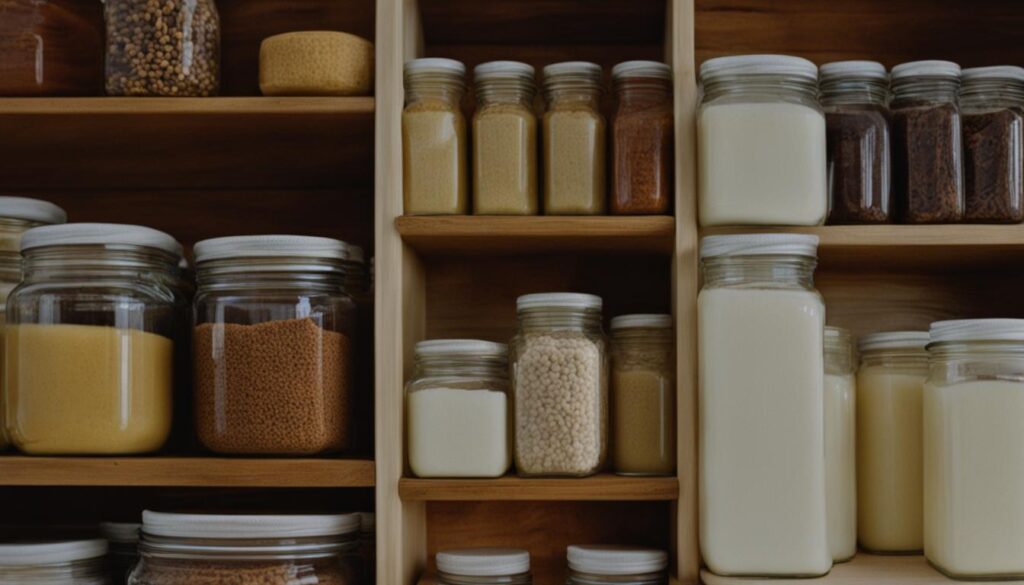
Proper storage of cocoa butter is crucial to maintain its quality and prevent spoilage. By following a few simple guidelines, you can ensure that your cocoa butter remains fresh and usable for an extended period.
Firstly, it’s important to store cocoa butter in a cool, dry place away from direct sunlight and heat sources. High temperatures can cause the butter to melt or become rancid, impacting its texture and aroma. To preserve its integrity, find a designated spot in your pantry or cupboard where the temperature is stable.
Additionally, when storing cocoa butter, it’s best to keep it in a sealed container or package to minimize exposure to air and moisture. Air and moisture can degrade the quality of the butter, leading to its deterioration. Therefore, ensure that the container or package is tightly sealed to maintain its freshness.
If your cocoa butter has melted due to high temperatures during storage or transportation, it’s essential to allow it to solidify again before using it. Gradual cooling or refrigeration can help with solidification, ensuring that the cocoa butter regains its proper consistency.
When properly stored, cocoa butter has a long shelf life of up to several years. However, it’s always advisable to check the expiration date on the product packaging and follow any specific storage instructions provided by the manufacturer. This will help you gauge its freshness and ensure optimal quality.
In summary, storing cocoa butter in a cool, dry place, away from sunlight and heat sources, is essential to maintain its quality. Sealing it in airtight containers and allowing melted cocoa butter to solidify again are crucial steps in preserving its freshness. By following these storage tips, you can enjoy the benefits of cocoa butter for an extended period.
The Verdict on Cocoa Butter
While scientific evidence supporting the specific benefits of cocoa butter is limited, many people enjoy using it for its pleasant texture and potential skincare benefits. Cocoa butter is a versatile ingredient with a wide range of culinary, personal care, and household uses. It is generally considered safe for topical use, although individual reactions may vary. When considering whether cocoa butter is worth it for you, it’s essential to assess your personal skincare needs and preferences.
When selecting cocoa butter, it’s recommended to opt for high-quality, pure, and unrefined products. These types of cocoa butter are more likely to contain beneficial compounds and nutrients. Additionally, proper storage is crucial for maintaining the quality and effectiveness of cocoa butter. Storing it in a cool, dry place away from direct sunlight and heat sources helps prevent melting and rancidity.
It’s important to note that the decision to use cocoa butter ultimately comes down to personal preference and individual skincare needs. While scientific research may be limited, many people find cocoa butter beneficial for moisturizing the skin, reducing the appearance of scars and stretch marks, and promoting overall skin health. Consulting with a dermatologist or healthcare professional can provide personalized skincare advice and guidance.
Conclusion
In conclusion, cocoa butter is a versatile ingredient that offers a multitude of uses and potential benefits. While scientific evidence supporting specific claims may be limited, many individuals have found cocoa butter to be effective in moisturizing the skin, reducing the appearance of scars and stretch marks, and promoting overall skin health. Additionally, cocoa butter is commonly utilized in the culinary, personal care, and household product industries.
When incorporating cocoa butter into your routine, it is crucial to select high-quality products, conduct patch tests to ensure compatibility with your skin, and store it properly to maintain freshness and effectiveness. If you have specific skincare concerns or questions, it is recommended that you consult with a dermatologist for personalized advice.
Ultimately, cocoa butter can be a valuable addition to your daily skincare regimen or the creation of culinary delights. Its rich and nourishing properties make it a popular choice among many individuals seeking natural solutions for their skincare and culinary needs.
FAQ
What are the uses and benefits of cocoa butter?
Cocoa butter has various uses and potential benefits. It is commonly used for moisturizing the skin, reducing the appearance of scars and stretch marks, and promoting overall skin health. It is also used in culinary, personal care, and household products.
Can cocoa butter be used on the skin?
Yes, cocoa butter can be used on the skin. It is rich in fatty acids that help moisturize the skin and improve its elasticity. Many people use cocoa butter for dry skin, scars, stretch marks, and even skin conditions like eczema and dermatitis.
Is cocoa butter good for hair?
Some people use cocoa butter in hair care products as it is believed to nourish and moisturize the hair. However, scientific evidence supporting specific hair benefits is limited.
Does cocoa butter help with scars?
Cocoa butter is commonly used to help reduce the appearance of scars. While there is limited scientific evidence supporting this claim, many people find cocoa butter beneficial for scar healing and prevention.
Can cocoa butter help with stretch marks?
Cocoa butter is often used to prevent and minimize the appearance of stretch marks. While results may vary, the moisturizing properties of cocoa butter can help keep the skin hydrated and improve its elasticity.
How does cocoa butter benefit dry skin?
Cocoa butter is an excellent moisturizer for dry skin. It forms a protective barrier on the skin, preventing moisture loss and keeping the skin hydrated and supple.
Can cocoa butter help with eczema?
Some people find cocoa butter helpful for managing symptoms of eczema, a skin condition characterized by dry, itchy, and inflamed skin. While cocoa butter can provide moisturization, it may not be suitable for everyone with eczema, and individual results may vary.
Is cocoa butter good for moisturizing?
Yes, cocoa butter is an excellent moisturizer. Its high fat content and moisturizing properties make it a popular ingredient in lotions, creams, and other skincare products.
Can cocoa butter help with anti-aging?
Cocoa butter is often used in anti-aging products due to its potential benefits for skin health. It may help improve the skin’s elasticity, reduce the appearance of wrinkles, and protect the skin from environmental damage. However, scientific evidence supporting specific anti-aging claims is limited.
Where does cocoa butter come from?
Cocoa butter is derived from cocoa beans, which are grown in tropical regions. The majority of the world’s cocoa beans come from West African countries such as Ghana, Nigeria, Cameroon, and Ivory Coast.
What are the key components of cocoa butter?
Cocoa butter is primarily composed of fatty acids, including stearic acid, oleic acid, and palmitic acid. It also contains phytochemicals, such as antioxidants and anti-inflammatory compounds, as well as small amounts of vitamins E and K.
Can cocoa butter be used in cooking?
Yes, cocoa butter is commonly used in cooking. It is a popular ingredient in chocolate production and can be used in various dessert recipes. Cocoa butter has a high smoke point, making it suitable for high-temperature cooking, and can also be used as a substitute for other oils.
What are the personal care and household uses of cocoa butter?
Cocoa butter is a common ingredient in moisturizers, lotions, lip balms, and other personal care products. It can also be found in hair care products, candles, and soaps due to its moisturizing properties and pleasant scent.
What are the benefits and applications of cocoa butter?
Cocoa butter offers potential benefits for skincare, such as moisturizing, reducing the appearance of scars and stretch marks, and protecting the skin from environmental damage. It is also used in culinary creations, personal care products, and household items for its moisturization, flavor, and texture.
Are there any tips for using cocoa butter?
When using cocoa butter, it’s recommended to choose a high-quality, pure, and unrefined product. It’s also advisable to do a patch test before using it on a larger area of the skin, especially if you have sensitive skin or allergies. Proper storage in a cool, dry place is important to maintain its quality.
How do I select the best quality cocoa butter?
To select the best quality cocoa butter, opt for pure and unrefined products without any additives or artificial ingredients. Consider purchasing from reputable brands or sources that prioritize sustainability and fair trade practices. Checking product packaging and customer reviews can also provide insights into the quality and effectiveness of the cocoa butter.
How should cocoa butter be stored?
Cocoa butter should be stored in a cool, dry place away from direct sunlight and heat sources. Ensure it is in a sealed container or package to prevent exposure to air and moisture. Melting can occur if exposed to high temperatures, so it’s essential to keep it in a controlled environment.
Is cocoa butter worth using?
The decision to use cocoa butter comes down to personal preference and individual skincare needs. While scientific evidence supporting specific claims is limited, many people enjoy using cocoa butter for its pleasant texture and potential skincare benefits.






